|
Feedlots with NPDES or SDS operating permits should send their
annual reports to the MPCA by March 1, 2018. The form is available on the MPCA feedlot NPDES-SDS permit webpage. We encourage everyone
filing to download the document (wq-f3-22b), fill out the Word version, and
e-mail the completed report as a PDF document. Cover letters that accompany
permits include the e-mail address of your MPCA staff contact, or call your
MPCA regional office for the e-mail address to use. Paper copies of the
form may be requested by contacting the MPCA regional offices.
All land application records for the 12-month
period starting Sept. 1, 2016, through Aug. 31, 2017, must be submitted as part
of the report and on the included forms. For farms that do not transfer manure,
land application records can also be generated and submitted using the MPCA
excel based Manure Management Planner under Create Crop Year Records. A link to
the planner is located on the feedlot program Nutrient and Manure Management webpage.
Annual reports provide valuable information for determining compliance with
Minnesota’s feedlot rules. Failure to submit annual reports by the March 1
deadline may result in an enforcement action from the MPCA.
Back
to top
 The 2018 edition of the MPCA feedlot inspection record-keeping calendar is available on
the NPDES-SDS permit web page. You can download
the calendar and post it in the office, and use the daily check boxes to record
regular inspections of water lines, weekly basin inspections and depth mark
readings, storm water and runoff controls, and perimeter tile inspections
monthly. The calendar notations would fulfill those NPDES and SDS permit
record-keeping requirements. A limited number of printed copies will be
available at MPCA regional offices and from staff.
Back to top
|
On Friday, Jan. 19, EPA filed a motion with the D.C. Circuit Court of Appeals seeking a three-month delay for issuing the mandate that farms with livestock (ranches, livestock operations and/or animal operations) be required to report hazardous substance air releases. No reporting is required until the Court issues its order, or mandate, enforcing its decision to eliminate the reporting exemptions for farms. EPA will be updating the reporting webpage daily to provide current information on the court mandate..
The mandate would require farms with livestock to report hazardous
substance air releases (ammonia and hydrogen sulfide) from animal waste under the Comprehensive Environmental
Response, Compensation, and Liability Act (CERCLA) when in amounts greater than/equal to their reportable
quantity within a 24-hour period. U.S. EPA factsheets and
FAQs provide an overview and basic information for those who are impacted
by this new requirement. If you have any questions, please
contact the Environmental Protection Agency at the information provided below:
This is the result of litigation since 2009 over emissions reporting for animal feeding operations. In 2008, EPA exempted all farm operations from continuous release reporting under the Comprehensive Environmental Response, Compensation, and Liability Act (CERCLA, also known as the Superfund law) and all but the largest operations from reporting to state and local emergency agencies under the Emergency Planning and Community Right-to-Know Act (EPCRA) law. The D.C. Circuit Court of Appeals struck down the exemption in April 2017.
Back to top
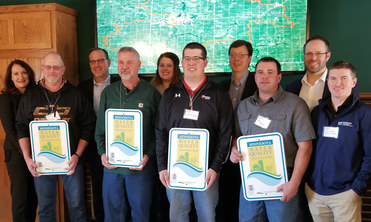 A first-of-its-kind Minnesota public-private partnership is helping improve water quality and address water resource challenges including flooding and sedimentation in the Cedar River Watershed in southern Minnesota. The Cedar River Watershed Project is a collaboration between CFS Cooperative, Land O’Lakes SUSTAIN, the Minnesota Department of Agriculture, Mower County Soil and Water Conservation District, Environmental Initiative and Hormel Foods Corporation.
Through this work, farmers in the watershed, which covers parts of Dodge, Freeborn, Mower and Steele counties, work with CFS and Land O’Lakes SUSTAIN to help implement precision agricultural practices that address water quality issues. In turn, the farmers can become certified in the Minnesota Agricultural Water Quality Certification Program (MAWQCP) through the Minnesota Department of Agriculture, which rewards farmers for implementing certain practices that help improve water quality by offering specially designated technical and financial assistance and regulatory certainty for a period of ten years.
Recently, Matt Wohlman, deputy commissioner of the Minnesota
Department of Agriculture, presented field signs for the MAWQCP program to four
newly certified ag producers from southern Minnesota – a fifth producer was
unable to attend. Three of the producers – Justin Krell, Rodney Krell and Larry
Schmeling – farm in the Cedar River watershed’s upper areas around the city of
Blooming Prairie.
The Ag Water Quality Certification Program has now certified over 500 producers across Minnesota helping improve water quality on over 300,000 acres. Together, the program will help keep over 23 million pounds of sediment out of our rivers, while saving nearly 54 million pounds of soil and 13,700 pounds of phosphorous on farms, each year. MDA news release.
Photo: L-R: Lori Marco, Hormel Foods; Larry Schmeling, area farmer; Matt Carstens, Land O’Lakes; Tom Besch, area farmer; Ashley Schmeling CFS; Justin Krell, area farmer; (Mike Harley, Environmental Initiative; James Nash Jr., area farmer; Matt Wohlman, MDA deputy commissioner; and Justin Hanson, Mower SWCD.
Back to top
|
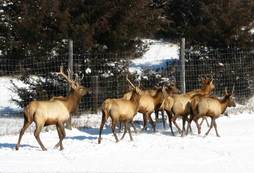 The Board of Animal Health has approved the
formation of a Farmed Cervidae Advisory Task Force. Staff had requested
stakeholder input on two issues of concern for the farmed cervidae program: 1)
development of guidelines for exclusionary fencing and 2) how farmed cervid
producers can remain viable business enterprises with CWD identified in the
state’s wild deer population and the regulatory restrictions on animal movement
that result from it. Based on these topics, the Board would benefit from
input from the following stakeholders:
- Accredited
veterinarians working with farmed cervids.
- Minnesota
Elk Breeders Association.
- Minnesota
Deer Farmers Association.
- A farmed
cervid producer at large (not a member of either organization above).
- A farmed
cervid producer that provides hunting of farmed cervids on their premises.
- A farmed
cervid producer that raises non-native cervid species (ex. reindeer,
muntjac, red or fallow deer).
- Minnesota
Department of Natural Resources staff.
- USDA
Veterinary Services staff.
Board staff will contact the government agencies
to identify appropriate representatives for this 15-member task force and are requesting
nominations for members from the other stakeholder groups. Provide information about nominations to Dr.
Linda Glaser at Linda.Glaser@state.mn.us by Feb. 1.
Back to top
|

Under
an agreement between the Minnesota Dept. of Agriculture (MDA) and the Barataria-Terrebonne National Estuary Program
in Louisiana, eligibility for Agricultural Best Management Practices (AgBMP) loans
in Minnesota will be expanded to include larger livestock operations.
With Minnesota’s formal recognition of the
Barataria-Terrebonne management plan, eligibility will be expanded to include
livestock operations holding National Pollution Discharge Elimination System (NPDES)
permits or those operations with more than 1,000 animal units.
“Work done to prevent pollution runoff in Minnesota as part of
this agreement ... is a simple, obvious and great step toward improving water
quality in the watershed and in our Louisiana estuary,” said Andrew
Barron, BTNEP’s senior water resources coordinator.
The dead zone, an area with low to no oxygen that occurs in
the Gulf of Mexico each summer off Louisiana and
Texas, kills fish and other marine life that fail to move out of the affected
waters. Last year, it spanned a record 8,776 square miles, about the size of
New Jersey, researchers said.
Since its inception in 1995, the MDA AgBMP Loan Program has
issued more than 13,000 low interest loans to Minnesota businesses and
landowners financing over $220 million for projects addressing erosion,
runoff, manure management, septic treatment, and drinking water problems. MDA
news release.
Back to top
|
Bartusek, VanOverbeke, VanBeusekom join MPCA feedlot staff
The MPCA feedlot program welcomes three new staff members in regional offices: Emily Bartusek starts Feb. 17 in Rochester, Klayton VanOverbeke started Jan. 18 in Marshall, and Reba Van Beusekom starts April 11 in Mankato.
Emily was the Winona County Feedlot Officer. Prior to that she worked for the DNR and Utah Dept. of Environmental Quality. She has a BS degree in Environmental Biology, completed certification for NPDES permit writing from the EPA, and more recently has completed the U of M’s Watershed Specialist on-line training course.
Klayton is a graduate from Southwest Minnesota State University with a BA in Biology. He has several years of work experience including as a farm hand in the Marshall area, a research assistant for Monsanto Soybean Research in Redwood Falls, and most recently a grow finish supervisor for Boerboom Ag Resources in Marshall.
Reba graduated from the U of M Twin Cities with a dual
BS in Environmental Science, Policy and Management and Chemistry. She is in the
process of completing her Masters in Analytical Chemistry, Aquatic Ecology,
Engineering and Environmental Science from the University of Montana-Missoula.
Reba has work experience as an inspector and water quality intern for PPL
Corporation and Xcel Energy. She grew up on a farm west of the Twin
Cities, competing in local 4-H dairy and beef cattle shows.
Minnesota Association of County Feedlot Officers conference March 27-29
The annual conference of the Minnesota Association of County Feedlot Officers is scheduled for March 27-29 at the Marriott Courtyard Hotel in St. Cloud. The event provides training credits for county feedlot staff, and a local feedlot tour. Program topics include: Program updates, biosecurity, manure and nutrient management, process waste water, and construction stormwater. A registration form and full agenda reside on the MACFO webpage. Under the delegated program, 50 counties administer the state's 7020 feedlot rule with the exception of large feedlots requiring state or federal operating permits.
Delegated counties announce feedlot staff changes, vacancies
Several counties in the delegated county feedlot program recently announced staff changes. Jared Morrill has moved from Cottonwood to Martin
County. New county feedlot staff include: Amelia Meiners, Houston County; David Malakowsky, Waseca
County; and Jessica Hill, Pope County. County feedlot staff vacancies remain in McLeod, Cottonwood, and Winona counties. Big Stone and Jackson counties are seeking additional feedlot program staff. A list of county feedlot staff resides on the MPCA's county feedlot program webpage.
MDA web page links to animal ordinances by county
The Minnesota Dept. of Agriculture has created a webpage with links to county feedlot ordinances. Every County in Minnesota has some ordinances regulating animal agriculture, and there is significant variation among them. MPCA feedlot regulations address issues related to water and air quality. Counties oversee zoning, land use, and setback issues. The webpage provides access to a general review of what is required for new or expanding livestock facilities at the county level during their planning stages. The webpage includes a map of Minnesota counties. A county can be clicked on and a brief overview of their ordinance pertaining to livestock/feedlot facilities is generated, plus a link to the full ordinance if available. MDA Animal Ordinances.
MPCA feedlot staff attend 2018 Pork Congress
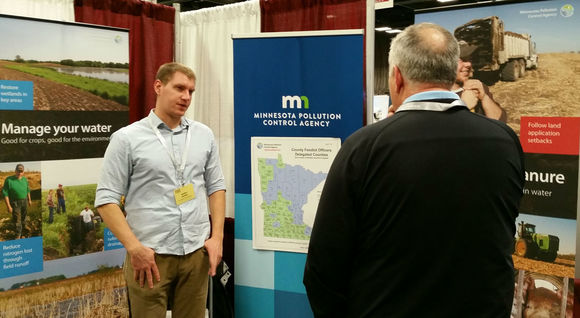 Walter Jordan, MPCA feedlot staff person in the Mankato office, talks with a visitor at the MPCA's booth at the 2018 Pork Congress in Minneapolis. Also attending were Lisa Scheirer, a feedlot program supervisor; George Schwint, feedlot program engineer; and Forrest Peterson, public information.
Back to top
The Minnesota Pollution Control Agency (MPCA) is considering an
update to its water fees and has created the Water Fee Advisory Committee to
provide input to the Commissioner on this important topic. An orientation meeting
of the Water Fee Advisory Committee was held on Jan. 8 at the MPCA
St. Paul office. The Advisory Committee plans to meet monthly through June 2018.
Meetings will be held at the MPCA St. Paul office and are open to the public.
Information about meeting dates, agendas, notes, and related
materials will be available on the Water Quality Fee Rule webpage. The webpage also contains information about the water fees.
Back to top
Farmers, agronomists and other ag professionals with an interest
in nutrient management and water issues are encouraged to attend upcoming
conferences showcasing the latest research on fertilizer and manure management,
water quality and tile drainage, and more.
The Fourth Annual Nitrogen: Minnesota’s Grand Challenge
and Compelling Opportunity Conference will be held Feb. 6 at the
Rivers Edge Convention Center in St. Cloud, with registration beginning at 8:15
a.m. Attendees can expect to learn more about cover crops, tile drainage and
on-farm testing to improve profitability and water quality. Speakers include
Dr. Matt Helmers, Iowa State University; Dr. Howard Brown, Illini FS; along
with several University of Minnesota researchers. Click here to register.
This year marks the tenth Annual Nutrient Management Conference.
Conference will be held Feb. 20 at the Verizon Conference Center in Mankato,
with registration starting at 8:15 a.m. Sessions will cover trends in
phosphorus and sulfur management, in-season nitrogen applications and cures for
phosphorus runoff losses from farmland. Dr. Don Flaten, University of Manitoba
and Dr. Emerson Nafziger, University of Illinois will be joined by Minnesota
researchers. Click here to register.
Hosted by the Minnesota Agricultural Water Resource Center and University of Minnesota
Extension along with the Minnesota Department of Agriculture and several other
sponsors, the two conferences continue a partnership effort that has grown in
recent years and attracts several hundred attendees. Several presentations will
provide updates on research funded by the Agricultural Fertilizer Research and
Education Council, an industry-led program funded through an assessment on
fertilizer sold in Minnesota. Learn more about AFREC here.
Certified crop advisors will earn continuing education credits in nutrient
management and water quality. To register, go to http://mawrc.org/events/. Online registration
is encouraged but not required. Conference registration is $20 up to one day
prior to the event, which can be paid online (requires a $3.16 service fee) or
at the door by check or cash. On-site registration is $25, payable by cash or
check. For the latest nutrient management information, visit the UMN Extension Nutrient Management website.
Back to top
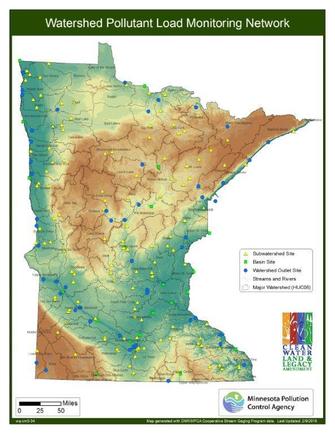
How’s the water? Is it getting better or worse?” Thanks to a
statewide monitoring network, funded in a large part by the Legacy Amendment,
MPCA scientists now have the long-term data to answer those questions.
In general, phosphorus and total suspended solids concentrations
in Minnesota’s larger rivers are decreasing or staying the same, while nitrate
concentrations are staying the same or increasing. However, because flows
have been increasing in some rivers, the total amount of phosphorus, total
suspended solids, and nitrate may be increasing even when concentrations stay
the same
Water quality also depends on location. Rivers and streams in
the central, north-central and northeastern parts of Minnesota – where more of
the forested land and wetlands are intact – generally have the best water
quality. The watersheds in the western and southern areas – where the land has
been significantly changed for farming and other development – have the poorest
water quality.
Watershed
Pollutant Load Monitoring Network
These trends are documented by the MPCA’s Watershed Pollutant
Load Monitoring Network (WPLMN).This network uses a multi-agency monitoring
design that combines site-specific streamflow data from the U.S. Geological
Survey and the Minnesota DNR. Local partners and MPCA staff collect water
quality data at 200 sites, which is paired with the stream flow information to
compute pollutant loads using a flow weighted mean concentration (FWMC).
The FWMC is like collecting all the water that passed a monitoring site into a
huge pool and taking one sample. This statistic can be used to determine how
clean or polluted a river is on average, allowing for the equal comparison of
stream water quality between watersheds differing in size or streamflow volume.
For more information about the monitoring network, please see
the WPLMN webpage, or contact MPCA hydrologist
Patrick Baskfield at 507-344-5240.
Back to top
|
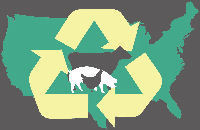
What would you (or your clientele) do if a natural disaster hit your area?
What changes should and do occur on a livestock operation during or following a
natural disaster, not only to ensure the safety and care of the animals, but
also the environments around the operation? Webcast Jan. 26 at
1:30 p.m. More
information... or register
for the webinar…. Speakers: Tommy Bass, Montana State University, Ronald
Gill, Texas AgriLife Extension, Carl Dahlen, North Dakota State University, and
Kevin Erb, University of Wisconsin Extension.
The fourth Waste to Worth conference is being tentatively planned for 2019 in
Minnesota. If you are interested in being part of the planning committee, fill
out this form.
The December 2017 Livestock Environmental Management
newsletter from North Dakota State University is available. Topics include
nutrient planning, the economic value of manure, and succession planning. Learn
more...
If you are interested in design of geosynthetic liners
for liquid manure storage, check out this recorded webinar from USDA NRCS. Read
more...
"Evaluation of low-cost hydrogen sulfide monitors
for use in livestock production" is the title of a recent study by the
University of Iowa. Gas monitors are important to protect farm workers from
dangerous hydrogen sulfide gas. Researchers examined different models and
differing conditions. They advise that bump tests are important to make sure
monitors accurately detect high levels of H2S gas. Read
more... | ASABE
Technical Library...
Back to top
|
DNR board approves measure to limit manure pollution in eastern Wisconsin to protect groundwater
Milwaukee Journal-Sentinel, 1/24/18
MPCA plans more intensive air quality monitoring of Goodhue County hog farm
Agri-News, 1/9/18
Variance for feedlot approved over city of Holland’s objections
Pipestone County Star, 1/17/18
Hog farm opponents file Supreme Court appeal
Rochester Post-Bulletin, 1/18/18
Assistance available to ag producers through Conservation Security Program
NRCS news release, 1/18/18
Back to top
Jan. 10-March 11: We Are Water MN exhibit, State Capitol east corridor.
Jan 24: Minnesota Ag Expo, Verizon Center, Mankato.
Feb. 6: Minnesota Nitrogen Conference, Rivers Edge Conference Center, St. Cloud.
Feb. 15: Minnesota Independent Crop Consultants Association winter meeting, Hutchinson.
Feb. 19: Nutrient, soil, and water management conference, Fergus Falls.
Feb. 19: Carver County Dairy Expo, Central High School, Norwood Young America.
April 12-14: State of the Water Conference, Breezy Point Resort, Brainerd.
March 13-15: Midwest Poultry Federation convention, St. Paul RiverCentre.
March 27-29: Minnesota Association of County Feedlot Officers convention, St. Cloud.
Back to top
The
MPCA Feedlot Update welcomes news from partners about, projects, people, and
upcoming events. Email submissions to forrest.peterson@state.mn.us.
Past issues of Feedlot Update are available on the feedlot program publications webpage.
|